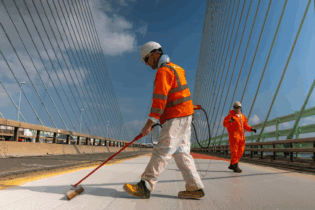Confidence in the future of SA’s construction sector reached its highest level in five years despite a marked decline in business activity in recent months.
This is the main finding of the Small and Medium-sized Enterprise (SME) Business Conditions Survey, conducted by the Bureau for Economic Research on behalf of the Construction Industry Development Board (CIDB). The index’s confidence level during the second quarter was 42, compared with 35 during the first three months of the year. The CIDB has seen a slow but steady rise for the past seven quarters since the early days of the pandemic, says CIDB CEO Bongani Dladla. Among general building contractors, who have been struggling for months, sentiments improved to 44 from 33. Confidence in the civil engineering sector was supported by better activity and rose marginally to 40 from 38. According to the survey, confidence trended higher even though activity deteriorated. A total of 46% of respondents stated that activity was lower than a year ago and that their overall profitability remained weak. “The construction sector has been hard hit by the economic downturn, which was aggravated by Covid-19. However, there are still positive sentiments that the industry might be on the road to recovery,” Dladla says. “The availability of work will remain under pressure for the foreseeable future. The vast majority of respondents, across the board, indicated that the lack of demand is a constraint on normal business operations,” added Dladla. From a grades perspective, contractors in grades three and four registered an uptick to 50 index points and grades five and six registered an uptick in confidence to 38 index points. Conversely, contractors in grades seven and eight registered a slight decline in sentiment.“According to contractors in grades seven and eight, activity worsened significantly in the second quarter of 2022. This is a turnaround from the trend in recent quarters and likely kept a lid on sentiment,” he adds.
Boosting confidence was a decline in tendering price competition as well as respondents’ own expectations for activity next quarter. Only 18% of respondents stated that tendering competition was keener than a year ago. This is the best level on record, but not enough to offset the effect of lower activity on overall profitability. Order books remained under pressure with 79% of respondents indicating that the lack of new building demand placed constraints on the business. More than half, or 51%, of those surveyed, cited a lack of access to credit as a major constraint. This is the highest level on record, Dladla highlights. Further, marginally higher levels in civil engineering activities were reflected in the survey. Respondents were also more optimistic with only 15% of participants predicting lower levels of construction activity in the third quarter of the year. “The rating of inadequate access to credit as a constraint jumped to an all-time high in the second quarter. Contractors seem to be faced with a number of headwinds, not only those posed by declining activity. This quarter, we also observed that firms are struggling with access to credit,” says Dladla. From a provincial perspective, there was a divergence in terms of confidence. Sentiment among contractors in KwaZulu-Natal increased markedly while a sharp drop was registered among contractors in the Eastern Cape. Confidence in Gauteng and the Western Cape was unchanged at comparatively low levels. Confidence in the Western Cape was stable despite the noticeably higher activity. Activity also improved in KwaZuluNatal but deteriorated significantly in Gauteng and the Eastern Cape. Looking ahead, work is set to remain under pressure, with the vast majority of respondents across the board indicating that the lack of new demand is a constraint on normal business operations. “The report is important for the entire country given the fact that the construction sector is a harbinger of broader economic activity,” Dladla concluded.







